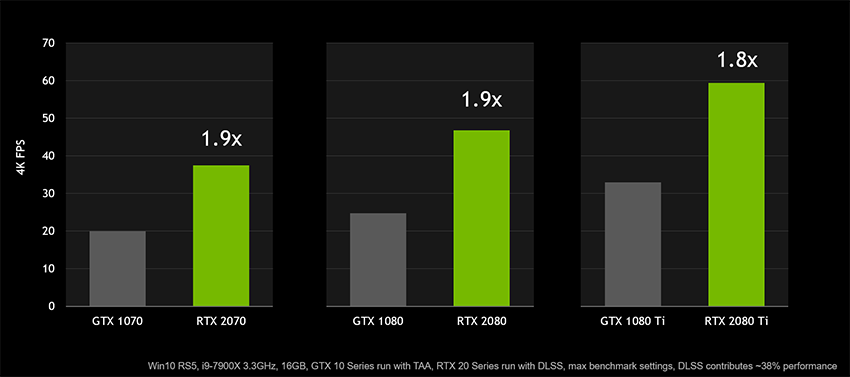GeForce RTX Gamers: Starting Now, Experience Battlefield V With Ray Tracing, And Test The Final Fantasy XV DLSS Benchmark
GeForce RTX graphics cards support new, innovative technologies that enable developers to add lifelike graphics to their games, to take advantage of AI-powered techniques that open the door to new opportunities, and to further accelerate performance.
To demonstrate these technologies in action, we’ve worked with partners across the world to develop new game integrations, demos and benchmarks, some of which you can download and experience for yourself right this second. For all the details, read on.
Battlefield V DXR Ray Tracing Is Available Now
BattlefieldTM V now features the first release of NVIDIA and DICE’s DXR ray-traced reflections technology, which adds lifelike, cutting-edge real-time reflections to surfaces and objects throughout Battlefield V’s single-player and multiplayer maps and modes.
If you want to experience the latest leap in graphical fidelity, realism and immersion for yourself, head on over to our dedicated Battlefield V DXR Ray Tracing article to see and learn more, and to discover how you can play Battlefield V with it enabled at home.
Windows 10 Update Delivers Industry-Wide DXR Support
The general release of the new Windows 10 1809 update promises to catalyze the development of a new generation of ray-traced games that bring lifelike lighting, reflections and shadows to real-time, interactive experiences.
This is all achieved using the Microsoft DirectX Raytracing API, which provides the entire gaming industry with a standard programming interface to utilize when crafting ray-traced content. And with the release of Windows 10 1809, available for download here, gamers with GeForce RTX graphics cards can play and enjoy the ray-traced titles built with DXR.
Learn more about ray tracing and how it’ll make games more realistic and immersive here.
Final Fantasy XV’s Updated Benchmark Demonstrates DLSS
Square Enix has updated their Final Fantasy XV: Windows Edition benchmark with Deep Learning Super Sampling, enabling GeForce RTX users to test the benefits of DLSS in Square’s massive action-RPG. And to personally experience its faster framerates:
Learn more and download the benchmark for yourself by checking out our dedicated article.
Wolfenstein II: The New Colossus Debuts NVIDIA Adaptive Shading
GeForce RTX graphics cards support several new, innovative advanced shading techniques, that enable developers to further improve performance, and do things that were previously impossible.
One of these techniques is NVIDIA Adaptive Shading (NAS), formerly known as Content Adaptive Shading (CAS). This adjusts the rate at which portions of the screen are shaded, meaning the GPU has less work to do, boosting performance.
Factors like spatial and temporal color coherence are measured each frame, and in areas where detail remains unchanged from frame to frame, such as sky boxes and walls, the shading rate can be lowered in successive frames.
Bethesda’s Wolfenstein II: The New Colossus is the first game to implement NAS, debuting the tech in a new patch that’s out now.
In addition, the Vulkan-powered Wolfenstein II benefits greatly from a number of new Turing-architecture improvements, including concurrent floating point and integer execution, and the new Turing cache and shared memory architecture. Together, Turing’s architectural enhancements and NAS result in Wolfenstein II: The New Colossus performance that's up to 70% faster than previous-generation Pascal-architecture GPUs:
For further details on the NVIDIA Adaptive Shading update, which is out now, head over to the Wolfenstein II’s Steam news feed.
There’s More To Come, Stay Tuned!
Here at NVIDIA we’re working with developers around the world to add DLSS, Ray Tracing, and other technologies to new, popular, and upcoming games, enabling you to experience each with the highest level of graphical fidelity possible, at astonishing framerates that were previously unobtainable.
For news on all of this work, and more, stay tuned to GeForce.com.


